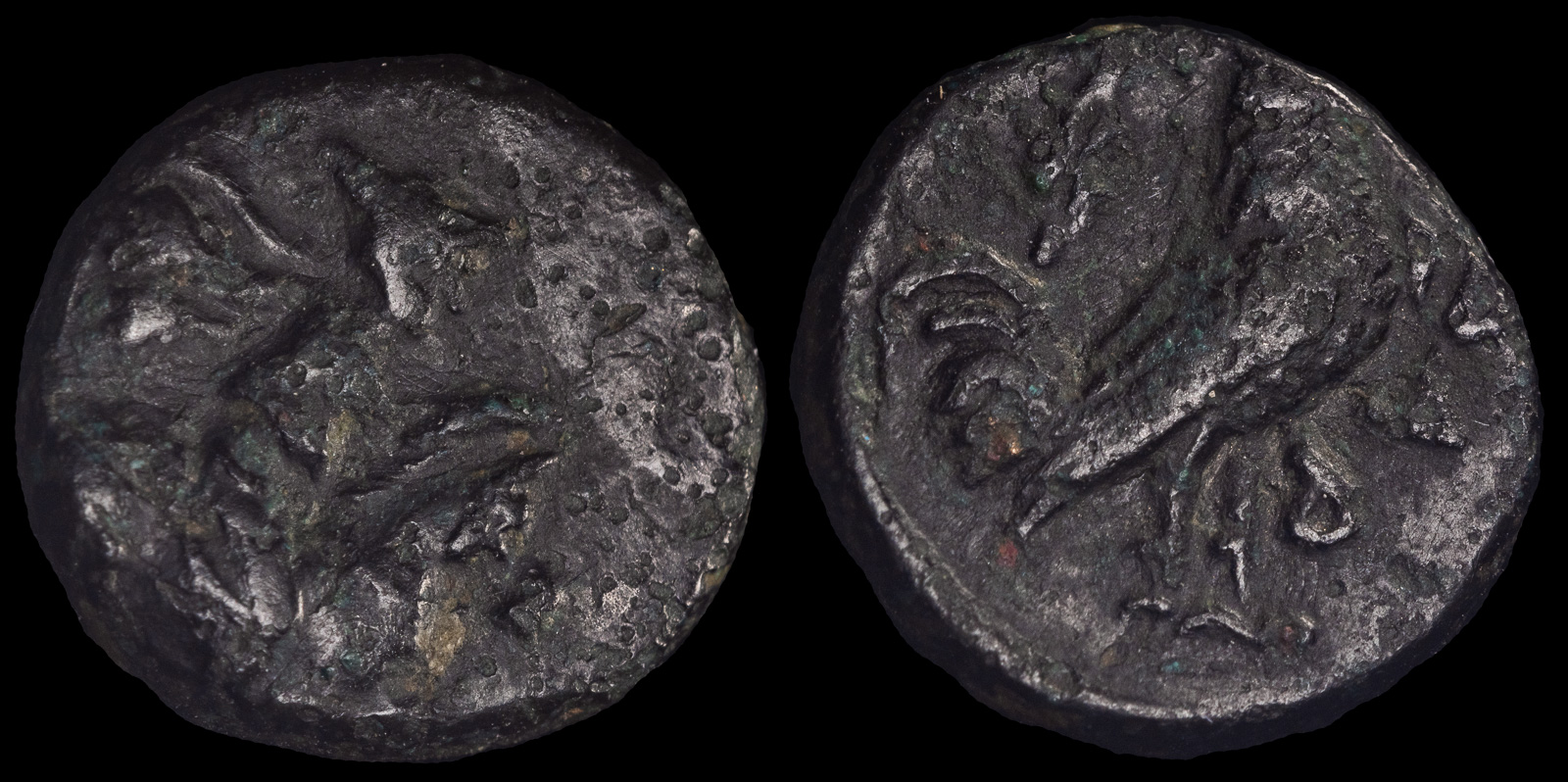
Troas. Dardanos
circa 300-200 BCE
Æ 11mm, 1,08g
Obv: Horseman galloping right, wearing petasos.
Rev: ΔΑΡ. Cock standing left.
This coin is a case of mistaken identity, though at least I didn’t pay a lot for it. It all started when I noticed what I thought was a Dardanos coin with a crab and won it for a low bid.
First, I verified the attribution. The obverse is clearly the same as the common Dardanos issues, which typically have a rooster. The horseman with petatos is similar to their issues of the 4th-3rd centuries, so my guess is this one was minted around then too. Those rooster issues also have the same treatment of the city name, and I found several where the ‘D’ is very faint – as if the engraver had forgotten about it. Given that, the attribution appeared straight on and I feel the coin is genuine, though it was probably minted some time before 200 BCE.
Second, I learned the story of Dardanos, who is basically the Greek version of Noah. He grew up in Arkadia, was a son of Zeus, and when the flood hit he went on an adventure with his brother Iason. The two went to Samothrace where Iason got busy with Demeter and was killed with a thunderbolt by Zeus. Dismayed, Dardanos moved on to the Troad, where he founded the city in his name. His ancestors were major allies of the Trojans.
Okay, but why the crab? I searched a bit more, and found that there’s a genus of hermit crabs in the Pacific called Dardanus.
“OMG!” I thought. “Clearly Dardanos had something to do with crabs in ancient times and I’ve found the link! My coin has major historic value!”
Well, not quite, but this was getting interesting.
I searched from two angles.
What did Dardanos have to do with crabs?
Why were those hermit crabs named Dardanus?
I assumed that the two would lead to the same fact, but was disappointed.
First, as far as I can tell, Dardanos had nothing to do with crabs. I picked up my Strabo and poured through the entry and searched for every paper (there aren’t many) that mentioned the legend of Dardanos. No crabs.
Perhaps the biggest hint comes from another coin of mine, minted in Priapos – which was very close to Dardanos.
Unlike Dardanos, Priapos commonly minted coins with crabs, though they minted crayfish too. The two coins are also of a similar size and weight and presumably were minted around the same time. Crab coins are most famous from Akragas in Sicily, though it had fallen out of power by this time. They were also known from the island of Kos, which was related to the word for crab. At the time of these coins, Kos was a powerful city. I briefly explored whether Kos may have controlled both Priapos and Dardanos for a time, but found no such association. The crabs from their coins also look quite different.
Crabs were also symbolic of Poseidon, and were used by an image for states that wished to brag how they were adept on both land and sea. As far as I can tell, both cities just seemed to like the symbol. Perhaps there was a brief (but lost) cooperation between the neighboring cities, where Dardanos minted coins with crabs in appreciation. That being said, the Priapos crab is depicted differently.
Maybe some guy in Dardanos started minted the crabs and Priapos sued for copyright infringement? I really don’t know, but my suspicion is Dardanos had a brief infatuation with crabs, and so minted the coins. I’d love to find a better story, but that so far seems the most plausible.
As for the second question, I wasn’t able to locate a site that explains the meanings behind genus names, but I did find clarification that the crabs were named after the same mythical Dardanos. My suspicion is the name came from his implication in the Greek flood story, and had nothing to do with Dardanos interacting with a crab. Therefore, the city and the crab were named after the same person, but otherwise shared no connection other than both being crabs.
So, it was a mystery for me until I posted the coin and multiple people showed me that it was actually an off-centered rooster, and not a crab.
Later on, I added this coin – where the rooster is more obvious.

Dardanos, Troas
4th-3rd century BCE
Ae 11mm 1.1g
Obv: Horseman riding right wearing petasos
Rev: DAP; Rooster standing right, race torch behind
SNG Cop. 290
Dardanos founded in legend by Dardanus, son of Zeus by Elektra.
Reign of Erichthonios in Dardanos.
Tros, from whom the Trojans are named, reigns in Dardanos.
Death of Mania of Dardanos, having been strangled by her son-in-law.
Sulla defeats Mithridates VI and ends the Mithridatic Wars with the Treaty of Dardanos. Adramytteion, Ephesos, Pergamon, Smyrna, Sardis, Tralles, Kolophon, Apamea, and Magnesia return to Roman control.